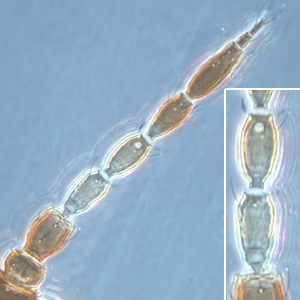Figures
Fig. 1: Antenna (inset: III. and IV. antennal segment)
Fig. 2: Head dorsal with ocellar triangle
Fig. 3: Pronotum
Fig. 4: Meso- and metanotum
Fig. 5: Forewing
Fig. 6: Sternites V and VI, female
Fig. 7: Sternites VI and VII, male
Fig. 8: Tergite VIII-X
ITS-RFLP gel patterns (1&8 ladder, 2 PCR-product, 3 RSAI, 4 HaeIII, 5 MspI, 6 HinfI, 7 AluI)
Fig. 9: Primer pair TODA1/TODA2
Taxonomic Information
Species:
Anaphothrips sudanensis Trybom, 1911
Synonyms:
Anaphothrips (Neophysopus) piercei Moulton, 1936
Anaphothrips brachyptera Priesner, 1935
Anaphothrips bicinctus Hood, 1925
Anaphothrips bicolor Morgan, 1925
Anaphothrips transvaalensis Faure, 1925
Euthrips citricinctus Bagnall, 1919
Anaphothrips speciosus Hood, 1919
Euthrips alternans Bagnall, 1914
Neophysopus
medioflavus Schmutz, 1913
Euthrips (Anaphothrips) alternans Bagnall, 1913
Euthrips flavicinctus Karny, 1912
Anaphothrips sudanensis Trybom,
1911
Common name:
None established
Present taxonomic position:
Family: Thripidae Stephens, 1829
Subfamily: Thripinae (Stephens) Karny, 1921
Genus: Anaphothrips Uzel, 1895
Species Recognition
General information about the genus Anaphothrips:Cosmopolitan, the species in this genus are found on various herbs, grasses, shrubs and trees. Relationships within this genus are unclear (probably restricted to less than 40 species, (Nakahara 1995)). Antennal segments VII and VIII less than 0.5 times as long as segment VI (this segment is often divided by a suture near the apex), sometimes wingless or with short wings (pads). Several species are quite common on many different hosts. Head and pronotum are without well-developed setae (bristles or hollow hairs).
Typical character states of Anaphothrips sudanensis:
Body color
Bicolored
Antennae
Number of antennal segments: 8
Segment IV - forked sensorium: scarcely extending beyond base of segment V
Segments II and III shape: more or less symmetric
Segments III & IV sensoria: emergent and forked
Base of sensorium on antennal segment VI: no more than 2 times as wide as base of nearest seta
Terminal antennal segments: rarely elongate
Head:
Distance between bases of ocellar setae III: greater than width of first ocellus
Head shape between compound eyes: not prolonged
Ocellar setae III on head: arising on anterior margin of, or in front of, ocellar triangle
Postocular setae I: present
Surface of head, pronotum and fore legs: without strong reticulate sculpture
Ocellar setae I in front of anterior ocellus: present
Prothorax
Number of pairs of elongate pronotal setae: 0-3
Number of pairs of elongate posteroangular pronotal setae: 0
Pronotum shape: rectangular
Mesothorax
Mesothoracic endofurca: without median spinula
Metathorax
Metanotum: with campaniform sensilla
Metanotum major sclerites: with two major sclerites, metascutum and metascutellum
Metanotum median area: with at least some equiangular reticulation
Metanotum sculpture: without dominant sculptured triangle medially
Metathoracic endofurca: transverse, sometimes with simple median spinula
Wings
Wings: absent, or not longer than thorax width
or present and more than half as long as abdomen
First vein of forewing:
distinct from costal vein
Forewing anterior margin: with setae and cilia
but cilia longer than setae
Forewing color: alternating bands of dark and
light
Forewing costal fringe of cilia: arising at anterior margin of wing
Forewing costal setae at middle of wing: shorter than median width of wing
Forewing first vein setal row: incomplete, with setae not closely and uniformly
spaced
Forewing posterior margin cilia: undulated near apex
Forewing second vein setal row: incomplete, with setae not closely and
uniformly spaced
Forewing surface: not reticulate
Forewings surface: with veins, setae and microtrichia
Legs
Fore tibial apex: not extending around fore tarsus
Mid and hind tarsi: with two segments
Abdomen:
Abdominal pleurotergites: not covered in microtrichia
Abdominal segment X: never tubular, longitudinally incomplete ventrally in both sexes
Abdominal sternite II: with marginal setae but no discal setae
Abdominal
sternite III of female: without glandular areas
Abdominal sternite VII
median marginal setae: arising in front of margin
Abdominal sternites IV
, V and VI: with marginal setae but no discal setae
Abdominal tergites
IV & V median setal pair: much shorter than distance between their bases
Abdominal tergites V-VII: without paired ctenidia, sometimes with irregular
microtrichia
Setae on abdominal tergite X: slender
Surface of lateral thirds of abdominal tergites: without regular rows of
fine microtrichia
Ctenidia on tergite VIII: not present, but groups
of microtrichia
Tergite VIII posteromarginal comb of microtrichia: present,
complete medially
Tergite VIII posteromarginal microtrichia: long, slender
and regular
Biology
Life history:
As with other thrips species the life cycle from egg to adult is dependent on temperature. The full cycle can take a couple of weeks to over a month and adults may live for more than one month producing several generations in one year depending on seasonal weather.
Host plants:
Grasses, maize, sugarcane, rice and wheat.
Vector capacity:
None identified
Current known distribution:
In subtropical and tropical regions around the world.
Additional notes:
Breeds in leaves and stems of many
grasses and cereals and the feeding causes the grass sheaths to become
marked with reddish brown longitudinal marks similar to rust fungus.
Bibliography
BHATTI, JS (1999): The male genitalia of Anaphothrips
sudanensis trybom (Terebrantia : Thripidae). - Oriental Insects 33:
243-246.
Moritz G, Morris DC, Mound LA (2001): ThripsID - Pest thrips of the world. ACIAR and CSIRO Publishing Collingwood, Victoria, Australia, CDROM ISBN 1 86320 296 X.
Moritz G, Mound LA, Morris DC, Goldarazena A (2004): Pest thrips of the world - an identification and information system using molecular and microscopial methods. CBIT, University of Queensland,CDROM ISBN 1-86499-781-8.
Mound, LA (1968): A review of RS Bagnall's Thysanoptera
collections. Bulletin of the British Museum (Natural History) Entomology
Supplement II London.
Mound, LA, & Kibby, G (1998): Thysanoptera: An identification
guide, (2nd edition). CAB International, Wallingford and New York, 70pp.
Mound, LA & Marullo, R (1996): The thrips of Central
and South America: An Introduction (Insecta: Thysanoptera). Associated
Publishers, Gainsville.
Palmer, JM, Mound, LA & Du Heaume, GJ (1989): 2.
Thysanoptera, pp. 73. In Betts, CR [ed.], CIE Guides
to Insects of Important to Man. CAB International, Wallingford.
Stannard, LJ (1968): The Thrips, or Thysanoptera, of
Illinois. Illinois Natural History Survey. Vol. 29:4, 215-552.
Links:
Mound, LA (2005): Thysanoptera (Thrips) of the World
- A Checklist. http://www.ento.csiro.au/thysanoptera/worldthrips.html










